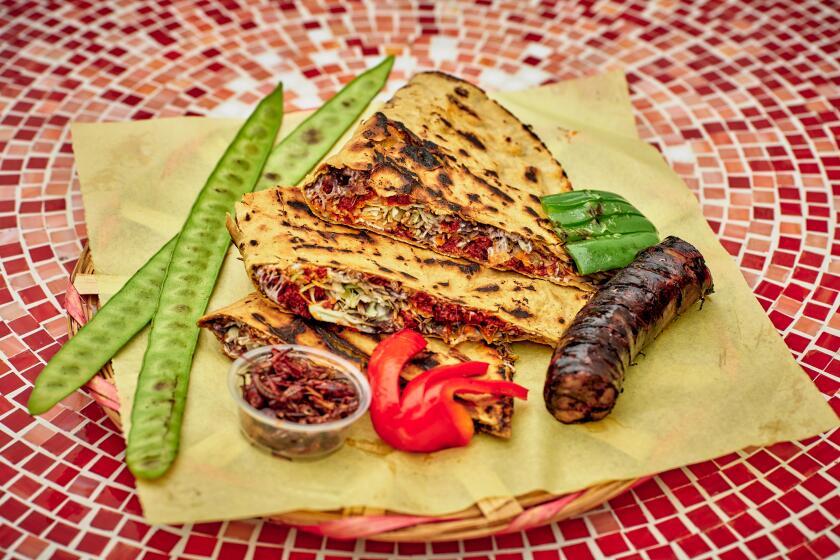THE HOME COOK : The Thrill of the Popover
The glory of popovers is their incredible size, their crusty outside, creamy tender inside and hollow center just waiting to be buttered and eaten while hot. Last week I made some and experienced the thrill of opening the oven door to find giant golden popover balloons, tall and proud and quaintly lopsided.
In the last few years I had about given up on making popovers. They would turn out to be sullen little muffins--pop-unders. Even though I did exactly what I remembered doing in the James Beard cooking classes, nothing worked. His popovers all but levitated. He said the secret of success was starting them in a cold oven, but even that didn’t work for me.
The solution to my problem was a tip in an old cookbook: “Oven-glass cups make the highest popovers.” I had been using muffin tins, which did not allow each popover to get the forceful amount of heat that quickly makes them puff and rise.
The popovers in the James Beard class were baked in old-fashioned cast-iron popover pans, which are hard to find today. Unlike muffin tins, they are separate cups, spaced apart but held together with bars. This allows the heat to encircle each container--hence increased heat to each popover.
The story of how popovers were born can be found in food historian Evan Jones’ book “American Food”: “Settlers from Maine who founded Portland, Ore., Americanized the pudding from Yorkshire by cooking the batter in custard cups lubricated with drippings from the roasting beef (or sometimes pork). Another modification was the use of garlic and, frequently, herbs. The result is called ‘Portland Popover Pudding,’ individual balloons of crusty meat-flavored pastry.”
Chicken Mock Hollandaise and broccoli are fine companions for popovers. You may use leftover cubed chicken for this dish, although I prefer to use leftover chicken cold, in salads or sandwiches, because reheated poultry has a faint undesirable taste. For this dish I half a small chicken and roast it in a 375-degree oven for 45 minutes. During the last 20 minutes of roasting I make the mock hollandaise sauce.
Popovers are meant to go with chicken, roasts, salads and soups, but they don’t belong with spaghetti, curries or chili. Make them exactly as directed. Nothing could be easier than this recipe, but like so many simple recipes you have to follow the directions or they won’t work.
You can also reheat popovers in a 350 degree oven for about 10 to 12 minutes. They will re-puff a little, not as high and mighty as the first time, but enough to be tasty.
POPOVERS
Butter or non-stick spray
1 cup flour
1 cup milk
1/2 teaspoon salt
2 eggs
Grease 6 (6-ounce) oven-proof glass cups with butter or non-stick spray.
Combine flour, milk, salt and eggs in small bowl. Beat briskly 2 minutes or until smooth. Fill cups 1/2 full. Place cups, without touching, on baking sheet. Bake at 425 degrees about 30 minutes, or until golden and feel light when 1 is lifted from cup. Serve immediately. Makes 6 popovers.
CHICKEN MOCK HOLLANDAISE
1/4 cup butter
2 tablespoons minced onion
3/4 cup chopped celery
6 tablespoons cornstarch, dissolved in cold broth or water
3 cups chicken broth
1 tablespoon lemon juice
Grated zest of 1 lemon, about 4 teaspoons
3 cups cubed cooked chicken
2 egg yolks, lightly beaten
Salt
1/4 teaspoon cayenne
Melt butter in saucepan over medium heat. Add onion and celery and saute until tender. Stir in dissolved cornstarch and cook over medium-low heat until smooth and blended. Slowly add chicken broth, lemon juice, lemon zest and chicken. Cook, stirring, about 3 to 4 minutes.
Beat 1/4 cup hot sauce into yolks. Stir back into saucepan. Cook 1 minute more. Season to taste with salt and cayenne. Serve with rice or noodles, if desired. Makes 4 servings.
More to Read
Eat your way across L.A.
Get our weekly Tasting Notes newsletter for reviews, news and more.
You may occasionally receive promotional content from the Los Angeles Times.










